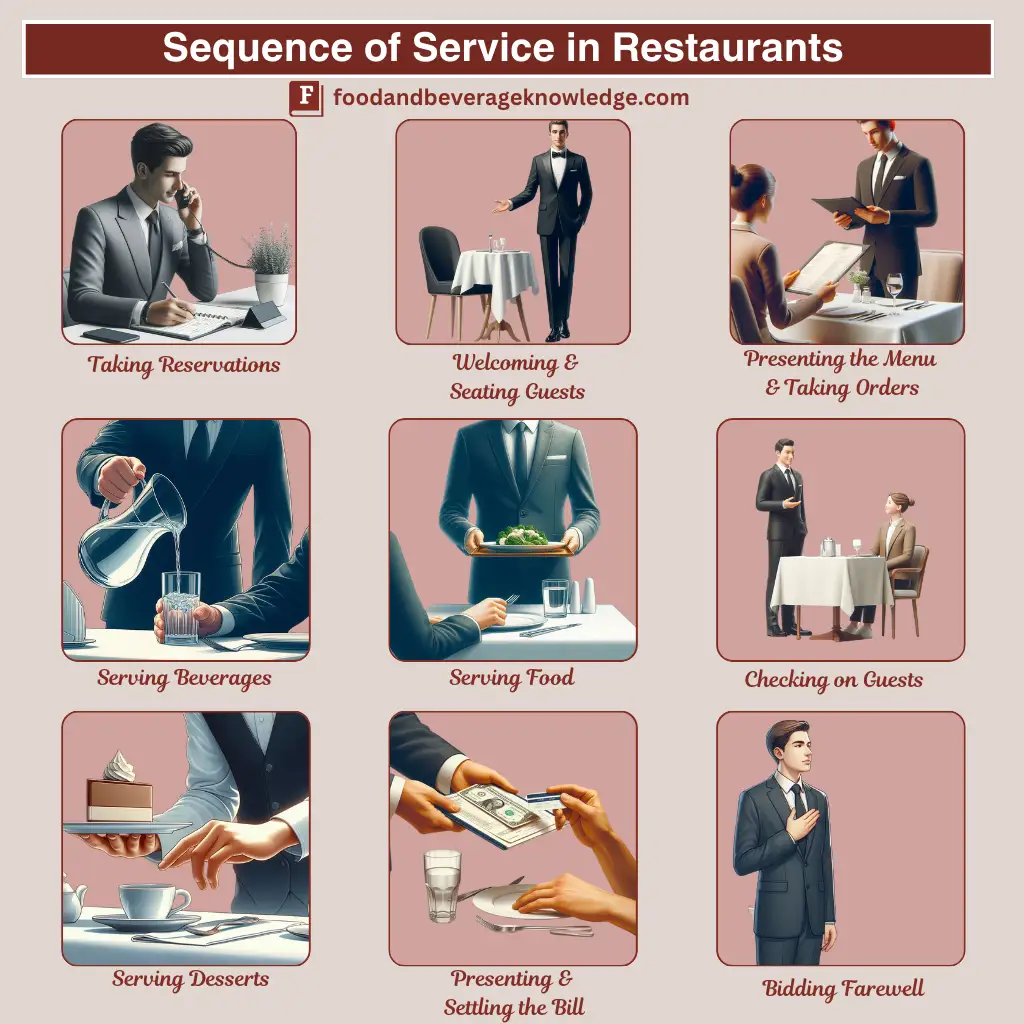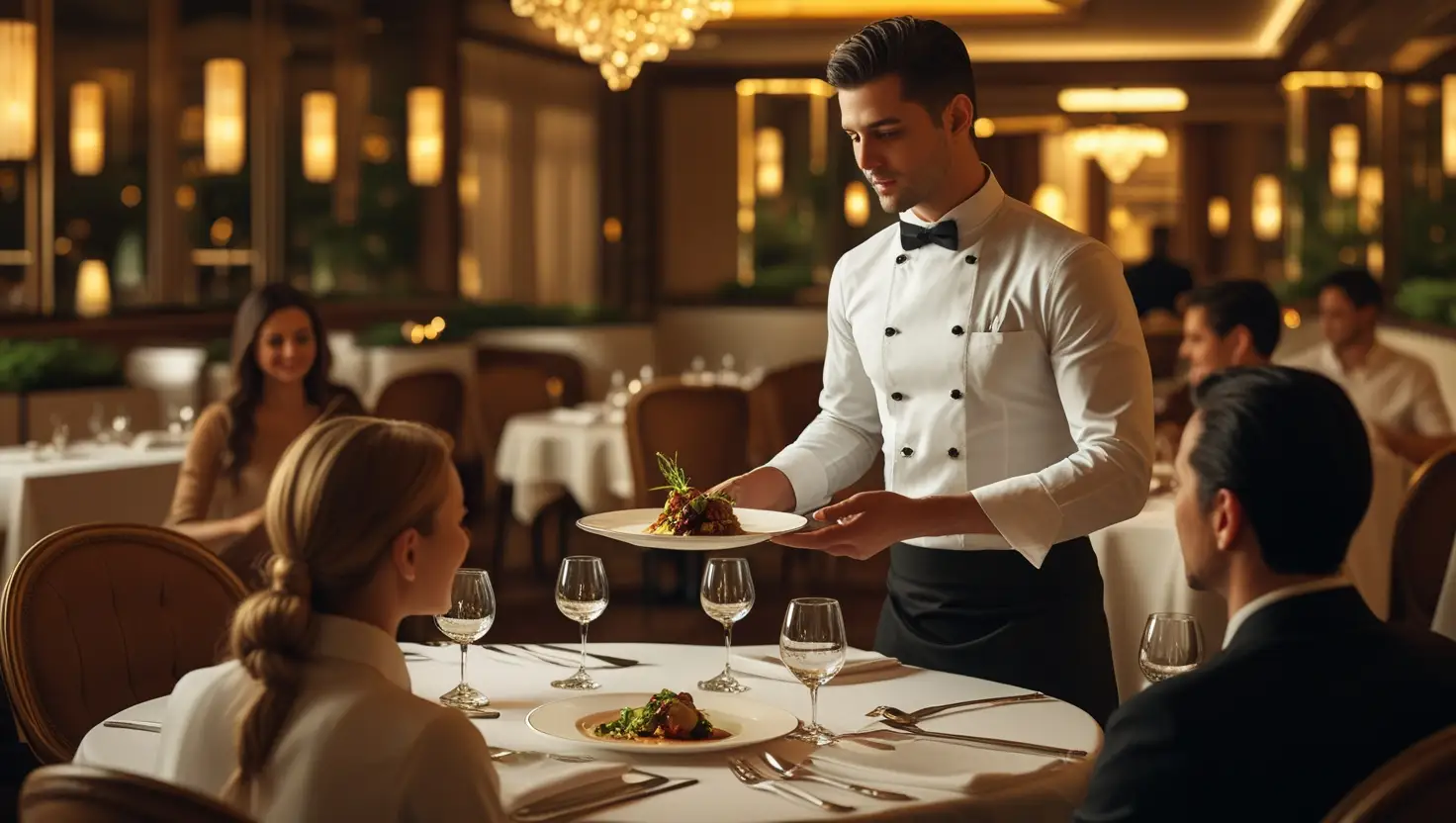In the restaurant industry, delivering exceptional service is just as important as serving high-quality food. A well-structured sequence of service ensures smooth operations, enhances customer satisfaction, and encourages repeat business.
From taking reservations to presenting the bill, every step in the dining experience must be executed with professionalism and attention to detail. Proper service etiquette, efficient communication, and a guest-centric approach contribute to creating memorable dining experiences.
This guide provides a comprehensive, step-by-step breakdown of restaurant service procedures, best practices, and essential skills for hospitality professionals.

Taking Table Reservations
A well-organized reservation system is essential for efficient restaurant management and ensuring a seamless dining experience. Handling reservations properly prevents overbooking, reduces wait times, and enhances guest satisfaction.
Best Practices for Managing Reservations:
- Answer phone calls and online inquiries politely and professionally, maintaining a warm tone.
- Confirm essential details: date, time, number of guests, and any special requests.
- Ask about dietary restrictions, seating preferences, and special occasions such as birthdays or anniversaries.
- Provide clear confirmation details via phone, email, or SMS.
- Maintain an organized reservation log to prevent double-booking and ensure smooth table management.
- Notify guests of any waiting times or policy changes related to reservations.
- If a reservation needs to be adjusted, communicate with the guest promptly and offer alternatives.
Welcoming and Seating Guests
The first impression of a restaurant significantly impacts a guest’s dining experience. Proper greeting and seating procedures set the tone for hospitality and professionalism.
a) Greeting Guests
- First impressions matter. Guests should be welcomed within 30 seconds of arrival.
- Approach guests with a warm smile, maintain eye contact, and use a pleasant tone.
- Use professional yet friendly phrases such as, “Good evening, welcome to [Restaurant Name]! How may I assist you today?”
- If the restaurant has a waiting list, provide an estimated wait time and offer seating at the bar or lounge if available.
b) Reservation Check and Seating
- If the guest has a reservation, confirm the details and escort them to their table.
- If there is no reservation, politely offer available seating options.
- Assist with pulling out chairs for guests, particularly for women, elderly diners, or guests with disabilities.
- Ensure guests are comfortably seated before handing over the menus.
- Offer to store coats, bags, or other belongings to enhance comfort.
Presenting the Menu and Taking Orders
A well-trained server should be knowledgeable about the menu and able to guide guests in making selections.
a) Presenting the Menu
- Hand menus to guests from their right side, ensuring each guest receives a menu.
- Briefly highlight daily specials, signature dishes, and new additions.
- Be ready to answer questions regarding ingredients, preparation methods, and portion sizes.
- Mention allergy and dietary accommodations available.
Related: What is Menu Planning? Definition, Importance, and Best Practices
b) Taking Orders
- Always start with ladies first, then proceed to men, and lastly, the host.
- Listen attentively and repeat the order to confirm accuracy.
- Offer pairing suggestions such as wine recommendations or appetizers that complement the main course.
- Provide guidance on portion sizes, spice levels, or chef recommendations to enhance the guest’s dining experience.
- Record orders accurately using a notepad or POS system to avoid mistakes.
- If a dish is unavailable, apologize and offer suitable alternatives.
Serving Beverages
Proper beverage service enhances the overall dining experience and demonstrates professionalism.
a) Water Service
- Offer still, sparkling, or tap water upon seating.
- Pour water without touching the rim of the glass.
- Refill water glasses regularly and discreetly.
b) Alcoholic and Non-Alcoholic Beverages
- Serve beverages from the right side, ensuring proper etiquette.
- For wine service:
- Present the bottle with the label facing the guest.
- Open the bottle in front of the guest.
- Pour a small tasting sample for approval before serving the full glass.
- Ensure coffee or tea is served with appropriate accompaniments, such as sugar, milk, or lemon.
- Check guest preferences for beverage temperatures (e.g., ice-cold soft drinks or room-temperature red wine).
Serving Food
The correct serving techniques ensure a professional and efficient dining experience.
a) Order of Service
- Follow this serving sequence:
- Appetizers
- Soups
- Main Course
- Side Dishes
- Desserts
- Women should be served first, followed by men, then the host.
want to learn about formal dining sequences? Read: 17 Course French Classical Menu with Examples & Description
b) Proper Serving Techniques
- Serve pre-plated dishes from the guest’s right side and platter to plate from left with a professional posture.
- Handle plates carefully and avoid touching the rim.
- Place dishes gently on the table to minimize noise.
- Announce each dish upon serving, e.g., “Here is your grilled salmon with lemon butter sauce.”
c) Checking on Guests
- Return within 2 minutes after serving to check if everything is satisfactory.
- Refill beverages and clear empty plates promptly.
- Be attentive but not intrusive, ensuring guests feel comfortable.
Clearing the Table and Pre-Dessert Service
Proper cleaning techniques ensure a smooth transition between courses.
a) Clearing Plates
- Remove plates from the right side once all guests have finished.
- Stack plates discreetly to minimize noise.
- Use a crumbing tray to clear the table before desserts.
- Offer a fresh napkin or palate cleanser before dessert service.
Serving Desserts and After-Dinner Beverages
a) Offering the Dessert Menu
- Present the dessert menu and offer suggestions based on the meal.
- Upsell coffee, tea, or after-dinner liqueurs.
b) Dessert Presentation
- Serve desserts from the right side.
- Use appropriate garnishes and ensure attractive plating.
Presenting and Settling the Bill
a) Bill Presentation
- Ask if the guests would like the bill before bringing it.
- Present the bill in a clean bill holder.
- Offer different payment methods (cash, credit card, digital payment).
b) Processing Payments
- Handle the payment discreetly.
- Thank guests and return the change promptly.
Bidding Farewell and Post-Service Duties
a) Saying Goodbye
- Thank guests sincerely: “Thank you for dining with us. We hope to see you again soon!”
- Offer assistance with coats and belongings.
b) Post-Service Cleanup
- Reset the table immediately for the next seating.
- Communicate guest feedback to the kitchen and management.
Common Mistakes to Avoid in Restaurant Service
- Ignoring guests or making them wait too long.
- Forgetting special requests.
- Improper handling of complaints.
- Overloading trays leads to spills.
Essential Etiquette and Best Practices for Waitstaff
- Always smile and maintain eye contact.
- Use polite and professional language.
- Never reach across a guest; serve from the correct side.
- Handle cutlery and glassware with care.
- Anticipate guest needs without being intrusive.
Conclusion
By mastering the sequence of service, restaurant staff can provide exceptional service, leading to positive reviews, repeat customers, and overall business growth. A well-trained team ensures a flawless dining experience, enhances guest satisfaction, and boosts restaurant success.
Related
- What is Room Service in Hotels? A Comprehensive Guide
- Handling complaints in food and beverage service
- Service of wine step-by-step, red, white and champagne
- What Are the Types of Food and Beverage Service in the Hospitality Industry?
- Food and Beverage Service 101: The Basics, Types, and Roles Explained
🎥 Watch the full video guide on Fine Dining Table Service below.
This visual training covers the complete sequence of service, perfect for hospitality students and restaurant professionals.
Subscribe and join our community of hospitality professionals & students — get insights, tips, and the latest updates delivered straight to your inbox!







